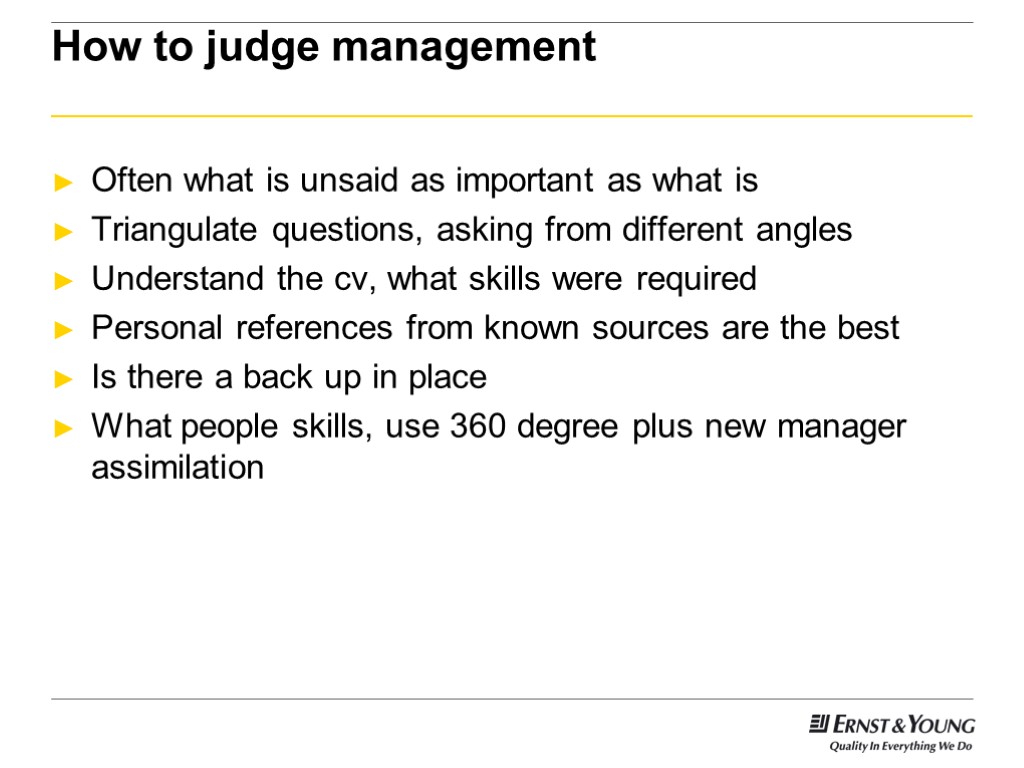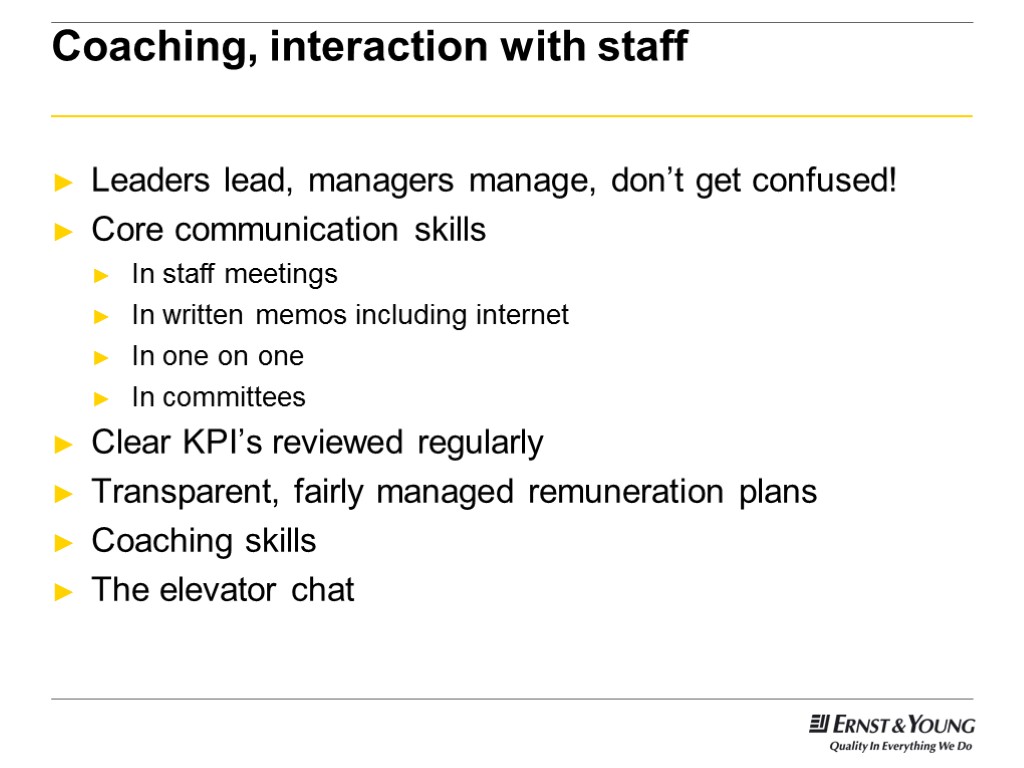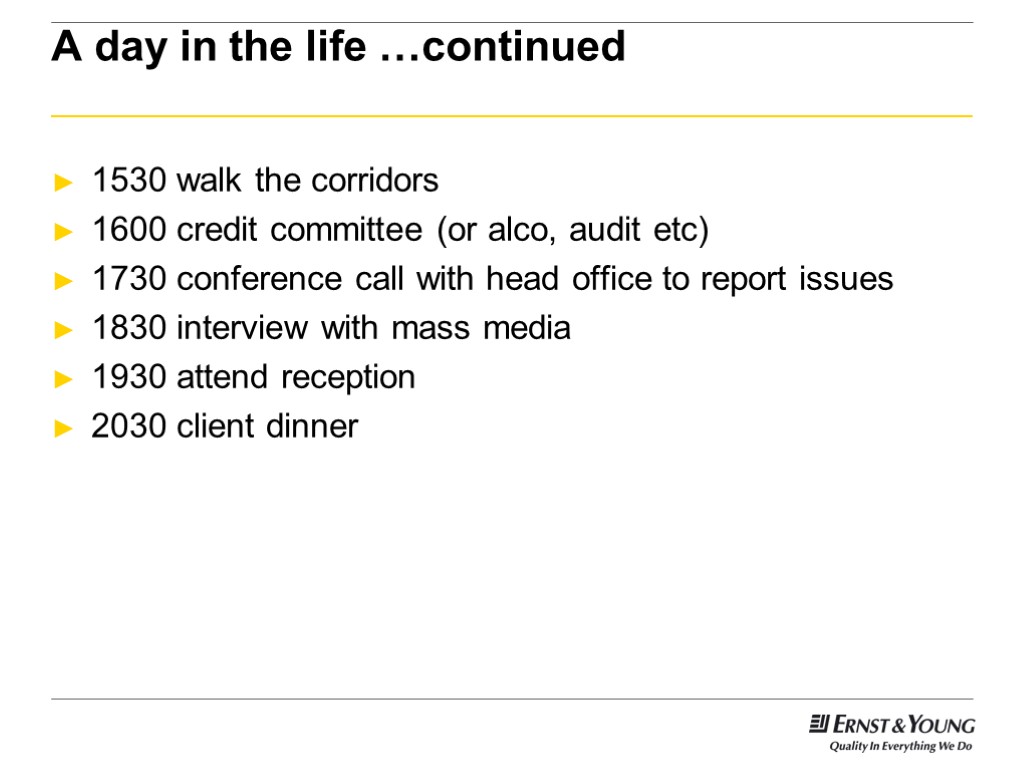Practical CEO How to go about running a


Practical CEO How to go about running a bank….

Purpose of the class What is involved in being a CEO What constituents? What are the areas you need to focus on? Who wants what from whom? What skills A day in the life of a ceo What can go wrong Summary

Role of the Ceo Leader not manager Provide strategic direction The primary, broadly defined risk manager Spokesperson for the company Arbiter of the senior management team Responsible for approving policies to create a controlled environment

Who are the constituents? Shareholders through the supervisory board Executive directors Staff Clients Suppliers The ‘public’ Regulators Tax and other government Organisational departments, direct and matrix

Understand the criteria that drive the shareholders’ definition of success What return on capital What market share and in what product What public image, message Review the strategy in light of market Tactics and timing, priorities Own the numbers, understand the dynamics of the business Build the right team Analyse existing resources Determine who to keep, replace, hire The first day’s checklist

The first day’s checklist continued Inventory full spectrum risks and determine hold, avoid, increase Differentiate between idiosyncratic and systemic Understand timing Review policies, practises, procedures Are they robust, appropriate, scaleable? Not just corporate but across the board, eg marketing, new product introduction Technology Create a 90 day plan Find early successes Don’t let the urgent crowd the important

First day checklist continued…… Conduct line reviews of core businesses Portfolio review, what risks and opportunities, any close in dangers? Recent trading performance, what might change? Ensure mark to market in treasury and portfolio How to position to maximise upside? Check in with key constituents Regulators and administration Customers Line and matrix managers Staff Competitors Suppliers

What do they want from me…. Understanding of the environment (now and in future) Economics Politics Industry and key developments Competition Culture Deep knowledge of the dynamics of the business By business line Dynamics of the cost structure Scenario analysis Ownership of broadly defined risk management Brand adherenc Controlled environment

What do I want from them…. Clear key performance indicators, for me, the business Capital, funding, counterparty limits Clear and understandable policies and practises Effective reporting systems that minimise the pain Appropriate products and technology Brand and public relations support Pool of talented, motivated staff with specific expertise

Some useful skills Communication external and internal, written and verbal Ability to judge existing and proposed management Coaching, interaction with staff How to run a meeting Time management Marketing capabilities Strong credit skills

How to judge management Often what is unsaid as important as what is Triangulate questions, asking from different angles Understand the cv, what skills were required Personal references from known sources are the best Is there a back up in place What people skills, use 360 degree plus new manager assimilation

Communication skills Start with the end in mind Structure the communication so that it is logical and simple to follow Say what you are going to say, say it and then summarise it Know your audience Time management

Coaching, interaction with staff Leaders lead, managers manage, don’t get confused! Core communication skills In staff meetings In written memos including internet In one on one In committees Clear KPI’s reviewed regularly Transparent, fairly managed remuneration plans Coaching skills The elevator chat

How to run a meeting Create a clear agenda outlining purpose and decisions to be made Circulate in sufficient detail with accompanying documents sufficiently ahead of time for participants to be able to absorb the material Create the’bolshoi rule’, everyone on time, no one gets in after the meeting starts Listen first and only comment after others Ensure time keeping, don’t let the meeting overrun Rapidly produce and circulate an agrred list of action plans, due dates and responsible people Maintain momentum…..

Time management

Marketing Clear set of goals for brand, product sales Determine what channels to be used Determine what the target audience is Ensure that there is a clear agency brief Use appropriate focus groups and surveys where necessary Explore non standard channels Create a baseline to enable tracking impact of differing programs

Credit skills No substitute for experience Conduct a portfolio review of 80/20 exposures Meet management and/or shareholders of all key credits Understand the purpose and structure of facilities Good credit initiation means getting behind the numbers, understanding strategy and competitive environment The second way out is only as good as the documentation Credit is not a one off event, it requires appropriate monitoring, and in person

A day in the life of a CEO 0800 check news, market update 0830 run through schedule of day with assistant, reorder where necessary priorities 0900 weekly business review with executive management team (or individually with line managers) 1000 briefing client management team for key messages 1015 client meeting 1130 initiative review with project team 1230 lunch with competitor, key industry player, client 1430 attend bankers’ association meeting, lobby

A day in the life …continued 1530 walk the corridors 1600 credit committee (or alco, audit etc) 1730 conference call with head office to report issues 1830 interview with mass media 1930 attend reception 2030 client dinner

Things that can go wrong…. People Initiatives from center IT problems, fires External, internal fraud PR disaster The outside world Competitors can strengthen Customers go bankrupt Banks cancel lines Laws change

Summary Integrity Clear, thought through strategic direction Understanding of the marketplace Good interpersonal skills Ability to motivate Technical knowledge Tactical common sense
practical_ceo.ppt
- Количество слайдов: 21

